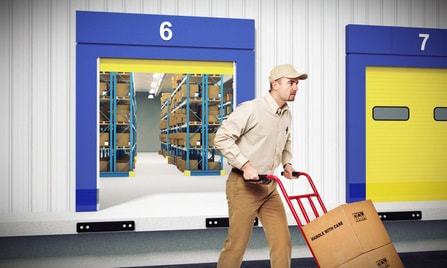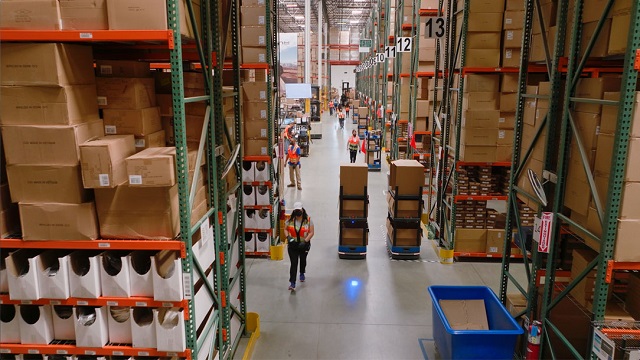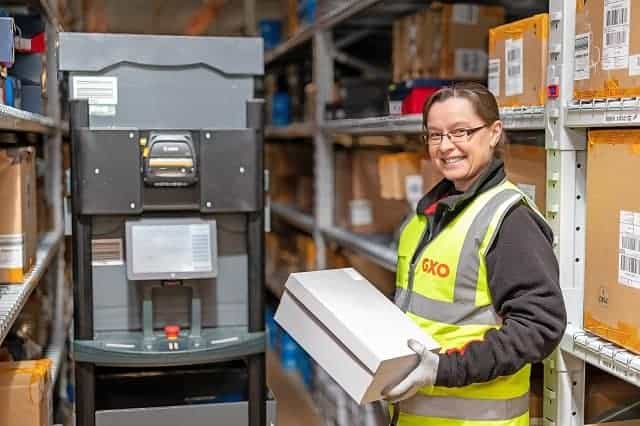For those in charge of warehouses and distribution centers, order fulfillment — the hyper-speedy kind — is a hot topic at the moment. Gone are the days of customers waiting a week (or more) for their order or to be processed, filled and delivered directly to their doors. These days, consumers are getting accustomed to rapid order fulfillment, especially those who live in cities where one-day or even three-hour delivery is a reality.
Because of the pressure to speed-up fulfillment, it’s important that all order fulfillment specialists, business owners and/or warehouse managers develop an order fulfillment system that fits the needs and demands of their customers. You might not be able to attain a one-day delivery promise by simply switching up your WMS or your picking routes. That said, you will get a better idea of what doesn’t work for your operation when you consider order fulfillment as a structured discipline.
To help you achieve your operational goals, we’ve put together a comprehensive guide to all things order fulfillment.
In this guide we’ll discuss:
- Different types of order fulfillment
- Software options to strengthen order fulfillment
- Inventory picking techniques
- The difference between omnichannel and multichannel fulfillment
- Common costs associated with order fulfillment
- Finding the best order fulfillment choice for you
- More resources on order fulfillment
Different types of order fulfillment

Before we get into the nitty-gritty, let’s first take a look at exactly what order fulfillment entails. Generally speaking, order fulfillment encompasses roughly 5 steps for most warehouses:
- Organization of the warehouse: This doesn’t just mean stacking inventory for space-saving; instead, it’s a SKU-fueled process that should be a strategic one. It is in this step that you will need to decide to integrate automated or collaborative technologies.
- Order management: If you’re still keeping records by hand, we’re willing to bet your accuracy is nowhere near where it should be. To remedy this, many warehouses and distribution centers invest in WMSs, ERPs or WESs to help drive precise fulfillment. As a bonus, many of the systems will give you on-demand reporting and analysis.
- Packaging: For packaging that’s handled in-house, you will need to invest in the right scales, machinery and associates to properly pack your inventory.
- Shipping: Not every warehouse deals with shipping directly. If yours does, be sure that you give the shipping company and your customer complete transparency so that all parties can track the parcel from transit point to transit point.
- Customer communication: This is the last step in the fulfillment process, but it’s an important one. You must keep an open line of communication with your customers. It seems like a no-brainer, but too many good companies let this step fall by the wayside.
Now that you know about the universal order fulfillment steps, let’s take a look at the main types of order fulfillment systems. These include:
- Self-fulfillment and shipping: This is the model that is used when all of your movements — manufacturing, inventory storage and warehousing operations — occur on the same site. In this model, a single operation handles picking, packing and shipping directly to the consumer.
- Third-party fulfillment: In this model, you give your inventory and outsource fulfillment of it to a third-party. Depending on the agreement, it is either you or the manufacturer that handles the order management. From there, the order is processed and the package is shipped directly to the customer.
- Drop-ship fulfillment: The drop-ship model only concerns warehouses that act as suppliers. In this case, it is your job to handle the shipments and orders of your drop-ship partner. The merchant selling the product doesn’t actually own or stock inventory.
Software options to strengthen order fulfillment

As briefly mentioned above, we are currently in an age when embracing new software and technologies is a must for warehouses. The standard for warehouses the world over is the WMS, otherwise known as the warehouse management system. A WMS is a software application that is designed to streamline a variety of warehouse processes, from customer service to billing. Here’s what a WMS can do for you:
- Strengthened end-to-end visibility: A comprehensive WMS can support communication with customers as well as throughout the supply chain for greater transparency. As an example, a materials supplier is able to see your accurate inventory level in real-time. What’s more, customers will also be able to successfully track their orders as they move through the fulfillment process.
- More accurate inventory counts and tracking: Let’s face it: automated systems are typically put into place to lessen the likelihood of human error. A good WMS goes beyond the capabilities of even your most organized associates by tracking and counting inventory automatically. Having this accurate info at your fingertips means manual inventory counts are required less frequently. And when it’s time to audit, the process is much simpler.
- Auto-generated reporting options: Reporting is necessary for many operational areas such as compliance, fulfillment protocols, safety and even human resources. Most WMSs come equipped with on-demand reporting, meaning you can generate reports in minutes instead of hours or days. With better access to up-to-date reports, you’ll have more visibility into key performance indicators and other important warehouse metrics.
Inventory picking techniques
If you’ve been in the warehouse management field for some time now, you’ve likely had the pleasure of experimenting with at least a few different warehouse picking techniques. If not — or if you are just in need of a refresher — take the time to read about the most common picking techniques below. 
- Zone picking: This is a suitable picking method to adopt if your facility is filling orders that contain multiple SKUs. With zone picking, inventory with unique SKUs are organized into designated zones and pickers are assigned to particular zones. A picker puts an item on a pick cart or collaborative robot and items are delivered to another zone (managed by another picker) until picking is complete for the order. Collaborative robots speed up this process by dynamically managing the boundaries of picking zones and handling transport between them, keeping pickers within optimized areas in the warehouse.
- Discrete picking: This is a suitable picking method to adopt if your facility’s orders are relatively straightforward. With discrete picking, the picker is assigned an entire order which they compile themselves one line at a time.
- Batch/multi-order picking: This is a picking method often used by e-commerce warehouse facilities with somewhat predictable ordering trends (i.e., food or apparel). With batch/multi-order picking, orders are assessed for popularity, then they are organized into batches by SKU. A higher number of pickers will be assigned to the more popular SKUs for faster picking as orders come in.
- Cluster picking: Cluster picking is a useful picking method to adopt if you are ready to implement automated picking technologies. With cluster picking, a single picker compiles multiple orders at the same time, typically while handling numerous SKUs.
- Wave picking: If your warehouse handles high-demand and diverse inventory, wave picking is a method to consider. Orders are assessed throughout the day and picking is scheduled in “waves” based on the level of priority. Pickers generally prepare each order line by line.
Remember, these picking techniques can be blended together and/or strengthened with the help of automation, such as collaborative robots like Chuck, which work with your human pickers to improve speed and accuracy.
The difference between omnichannel fulfillment and multichannel fulfillment
You’ve likely heard the terms omnichannel and multichannel before in relation to marketing strategy, but you may not know how they can affect your fulfillment strategies as a whole. First, let’s consider the definitions:
- Omnichannel fulfillment: Omnichannel fulfillment is a method in which the customer is placed in the “center” of the shopping experience. Because there are so many different ways to shop now, from online sites to social media to brick and mortar stores to even gaming consoles, the idea is that the customer should have the same experience no matter how they choose to shop. This means that all prices and return procedures should be identical across channels.
- Multichannel fulfillment: Multichannel fulfillment is a method by which the customer’s experience might vary slightly depending on how they shop. Though it still gives customers all of the shopping options that omnichannel does, it is made clear that prices and return procedures may not be the same across the board. Inventory for a company’s e-commerce store is typically stored separately from inventory for brick-and-mortar locations, and items purchased online may not be eligible for in-store returns.
Simply put, an omnichannel fulfillment strategy requires a seamless shopping experience across channels, a promise that can be hard to deliver. Of course, omnichannel fulfillment is preferred by shoppers but it must be something that you can deliver on — and it’s very much a strategy requiring full buy-in from the entire supply chain. Typically, this is so challenging that even some of the world’s largest retailers have switched back to multichannel after a failed omnichannel attempt.
Having said that, there are ways to successfully implement an omnichannel strategy. It all starts with integrating the right software. Usually, it requires a combination of an ERP, WMS, WEP and, of a course, a CRM for seamless customer communication. If you’re able to pull it off, you must prepare both your fulfillment facilities as well as your brick-and-mortar shops to ensure that they can handle increased returns processing.
Common costs associated with order fulfillment
Naturally, order fulfillment costs vary from facility to facility. Generally speaking, fulfillment-related costs fall under these 4 categories:
- Inventory receiving costs: If you work in third-party or drop-ship fulfillment, one cost that you will incur is the inventory receiving cost. This refers to the time and labor needed to accept and verify an inventory delivery. Typically, you would charge by the pallet or box.
- Inventory storage costs: This cost applies to all warehouses and fulfillment centers, regardless of the fulfillment method used. It refers to the cost of storing inventory in the warehouse. Usually, this value is determined based on space required and/or SKU.
- Order pick and pack costs: This is the amount of money it costs to pick and pack each order, including the cost of both human and automated labor.
- Shipping costs: Shipping costs may be taken care of by the customer or absorbed by the operation. Good news for warehouses — usually you get deep discounts, especially if exclusive contracts are signed with the chosen shipping company.
Finding the best order fulfillment choice for you

There is no one-size-fits-all when it comes to order fulfillment strategy. That said, there are ways to ensure that you are taking a holistic approach to fulfillment. Before you marry yourself to just one strategy, ask yourself these questions:
- Is my WMS or other software system giving me the support I need?
- Are my warehouse’s order picking times longer than they should be?
- Is the warehouse organized with speedy fulfillment in mind?
- Are my customers demanding an omnichannel approach?
- Have I properly assessed all of my fulfillment costs, including labor? Are there ways to reduce my fulfillment costs?
Once you keep all of the factors in mind, you’ll be well on your way to creating or redefining a fulfillment strategy that works best for you.
More resources on order fulfillment
For the latest information on all things order fulfillment, visit the following resources:
- Order Fulfillment Guide
- Shipping & Fulfillment 101
- A Beginner’s Guide to Order Fulfillment and Delivery
- Dropshipping Courses at Udemy
- Omnichannel vs. Multichannel Marketing: What’s the Difference?
- 7 Excellent Methods to Improve Picking and Packing Efficiencies
- How to Improve Your Order Fulfillment Process
- Warehouse Inventory Management: 10 Tips You Need to Know
- How to Select a Warehouse Management System


